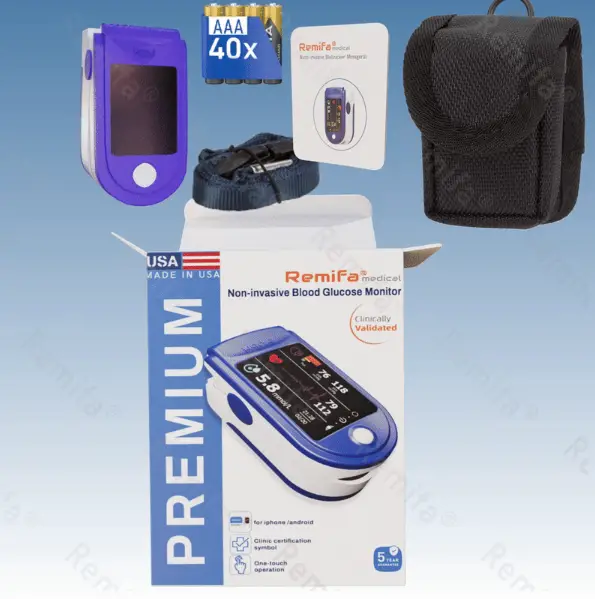Devices that claim to measure blood sugar without a finger prick are drawing massive interest, especially from people managing diabetes. Brands like Clinclii promise ADA/FDA-certified, pain-free, real-time glucose readings using “photon chip” or Lambert Beer’s algorithm. But do these claims hold up or is this marketing masquerading as medical innovation?
In this review, I’ll analyze what Clinclii claims, how the device allegedly works, assess the scientific credibility, flag major marketing red flags, and determine whether it’s legitimate or something better avoided.
Key Takeaways
- Clinclii markets a 99.9% accurate non-invasive glucose monitor, claiming FDA, ADA, CE, ISO 13485, and GMP certification.
- Purported technology includes light absorption spectroscopy and a proprietary “photon chip” using a Lambert-Beer algorithm.
- No independent studies or regulatory confirmation found; site markup and pricing resemble dropshipping funnels.
- Reddit and consumer reports describe similar devices as scams, often delivering only pulse oximeters.
- The FDA has warned explicitly that no smartwatch or wearable can accurately measure glucose non-invasively today.

What Is the Clinclii Non-Invasive Glucose Monitor?
Clinclii is sold through sites like clincliinoprick.com and similar domains. It’s branded as a compact optical health monitor for finger use, promising glucose, blood pressure, heart rate, and oxygen data in under 8 seconds. The device is priced around $20–40 USD, often sold with heavy discounts and subscription upsells. Despite claiming numerous certifications, there’s no legitimate Bayer or ADA product listing matching this device.
How It Claims to Work
Clinclii advertises that it uses optical absorption spectroscopy combined with “photon chip” technology and a Lambert-Beer algorithm to detect blood glucose through light absorption changes in the skin. Results are displayed on the device or synced via Bluetooth to a companion app. The brand claims 99.9% accuracy and global regulatory validation.
The Reality vs. the Claims
- The FDA has clearly stated that no wearable or smartwatch currently can measure glucose without an invasive sensor.
- Peer-reviewed research does not support fingertip optics as reliable for glucose detection; current prototypes still fail accuracy standards like MARD under 15%.
- Reddit users confirm many products (similar branding) shipped only pulse oximeters, never glucose monitors.
- Claimed certifications often lack traceability; research shows dropshipping domains reuse logos without verified approval.
Red Flags To Consider
Misleading Regulatory Claims
Certifications like FDA or ADA listing are mentioned without verifiable documentation or listing in official registries.
Inconsistent Technology Claims
Terms like “photon chip,” “Lambert Beer algorithm,” and “smart MCU controller” are vague and lack published technical validation.
Extremely Low Price vs. Medical Device Standards
Legitimate FDA-cleared glucose meters cost hundreds of dollars, not under $50.
Frequent Scam Reports on Reddit
Consumers report receiving generic pulse oximeters instead of glucose devices. Many describe the whole model as deceptive.
FDA Warning Applies to Devices like Clinclii
In 2024, the FDA cautioned that unapproved non-invasive glucose wearables are unreliable and potentially dangerous.
Does It Actually Work?
Given the absence of credible validation, clinical trials, traceable certifications, and user confirmation, Clinclii is almost certainly not capable of measuring glucose accurately. Any readings it produces are likely erroneous and unsafe for clinical or personal use. At best, users may get pulse oximetry or heart rate, but not blood glucose.
Where to Buy & Price Point
The device is widely sold via Clinclii-branded Shopify pages, Amazon knockoffs, and low-cost marketplaces for $18–40 USD. No official brand site or trustworthy retail channel is identifiable. Refund policies are unclear, and billing practices resemble marketing-heavy funnels.
Alternatives
- Dexcom G7 CGM
- FreeStyle Libre 3
- Contour Next Fingerstick Meter (Bayer)
- Accu-Chek Guide
What To Do If You Got Scammed
Get a Refund
Initiate a dispute with your card issuer and provide proof like emails, receipts, and screenshots.
Cancel Your Card
If charges persist, cancel the card to stop further billing.
Request a New Card
Ask your bank to issue a new card number and flag the previous one as compromised.
Report the Scam
- IC3.gov – For U.S. consumers
- Your country’s consumer protection agency
- Better Business Bureau – If sold by a U.S.-based vendor
Conclusion
The Clinclii Non-Invasive Glucose Monitor claims medical-grade performance at a fraction of the cost, but none of the claims hold up under scrutiny. The product appears to repurpose generic smartwatch or pulse oximeter hardware, with misleading branding and unverifiable certifications. Without transparent data or legitimate credentials, it should be considered unsafe and unreliable for glucose monitoring.
Verdict: Highly not recommended. Stick to legitimate, FDA-approved devices for safe diabetes care.
Also Read – Hilipert.com Review: Trustworthy or Fraudulent Online Store? Read This First!
